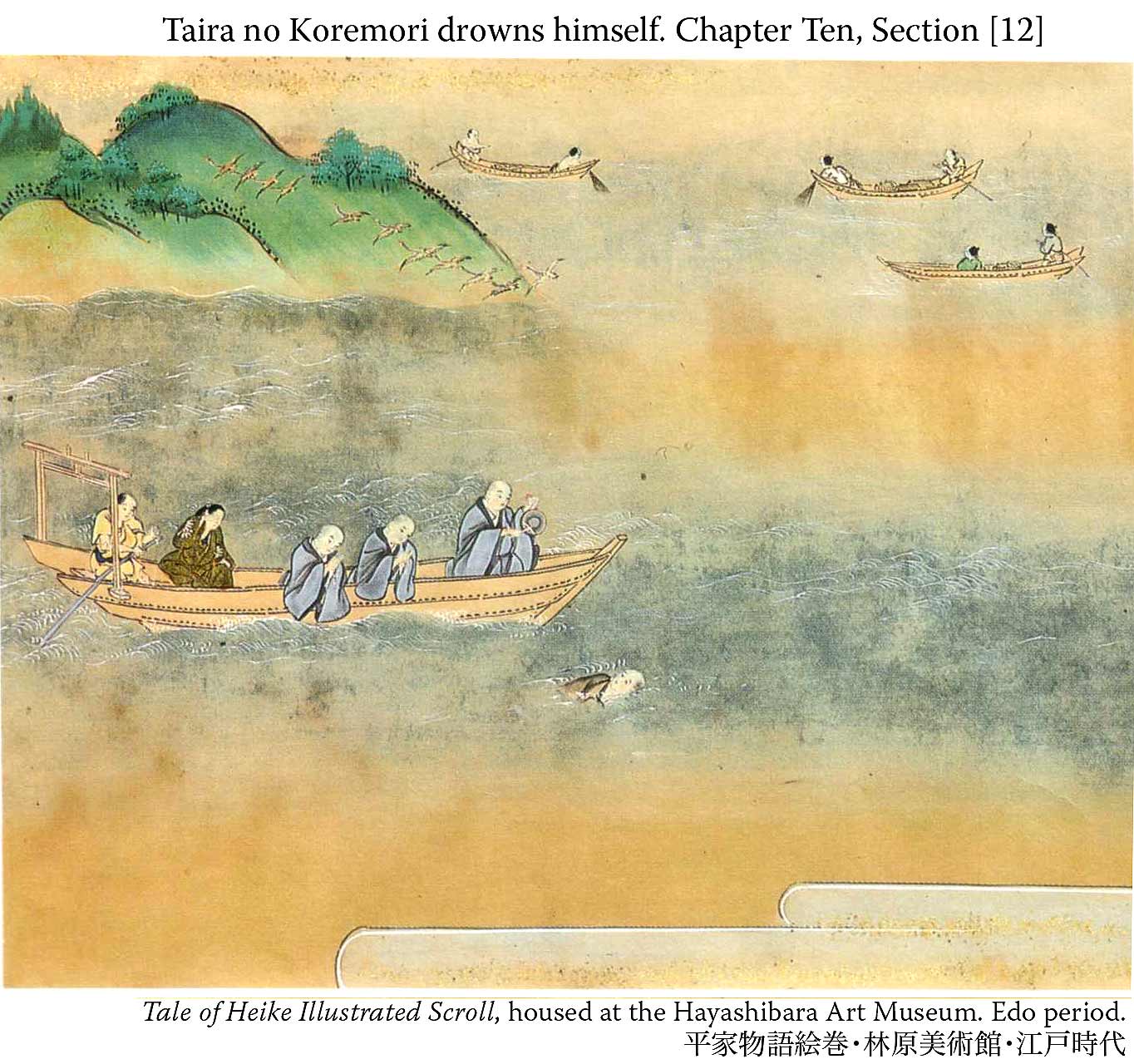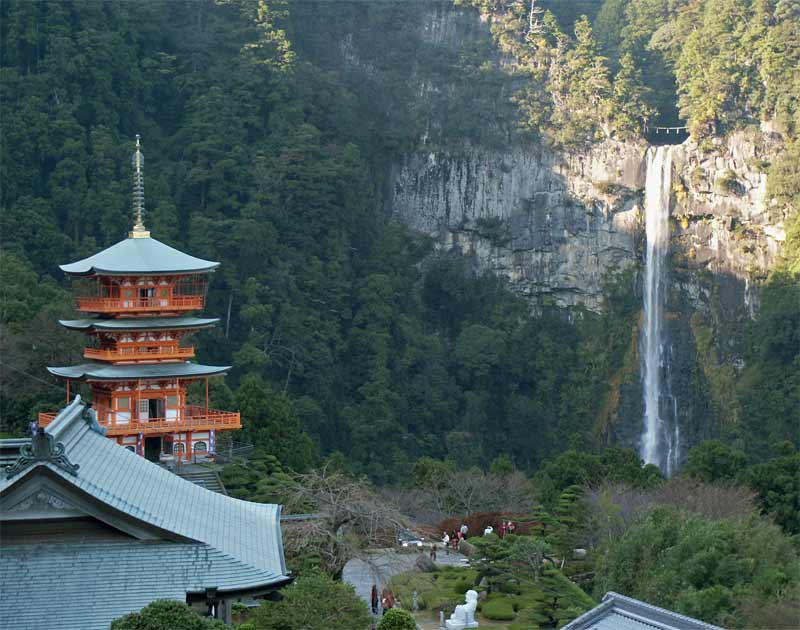Chapter 10 (Events of early 1184)
Jump to Section: 1, 2, 3, 4, 5, 6, 7, 8, 9, 10, 11, 12, 13, 14
Overview --- This chapter primarily follows the fates of Taira no Shigemori and Taira no Koremori. Shigemori is shown as a man of culture; Koremori is shown in particular as a man who accepts his fate honorably. This chapter has more than the usual amount of poetry.
Multimedia
Wooden statue of Yoritomo, at the Tokyo National Museum
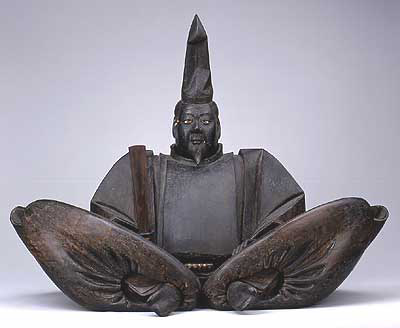
A portrait of Yoritomo by a contemporary, Fujiwara no Takanobu
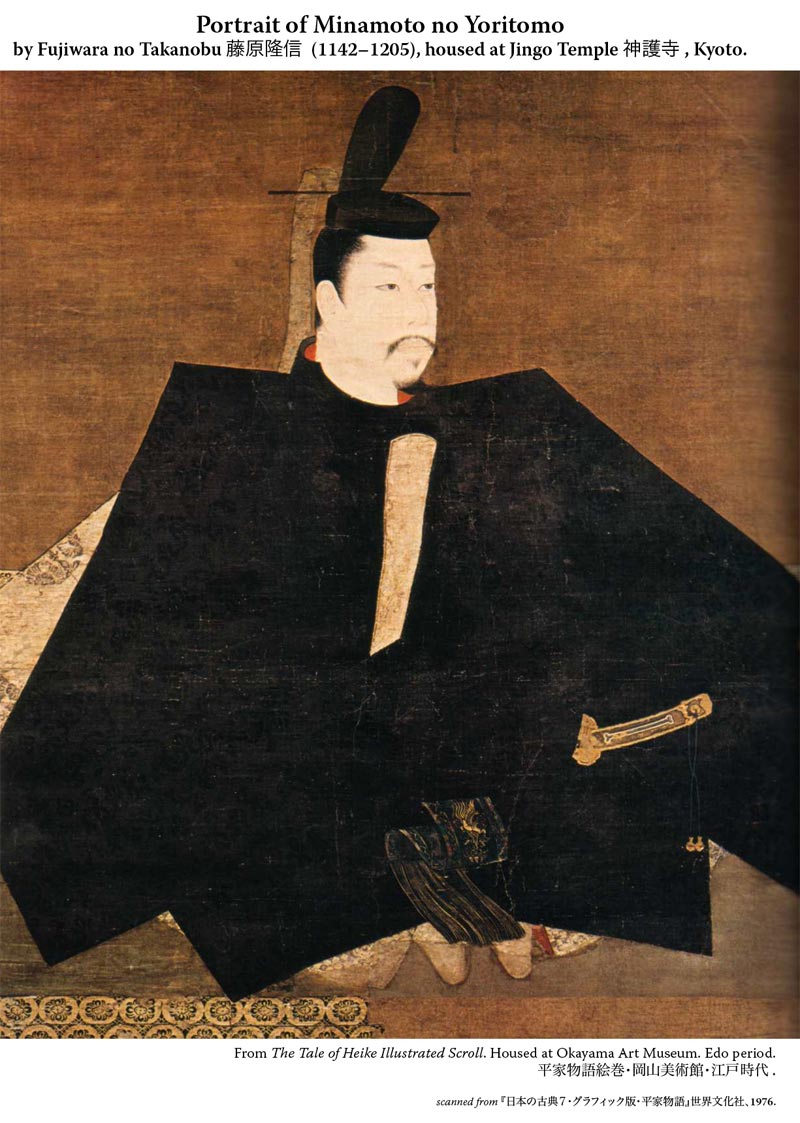
10-[1] The Parade of Heads --- The heads of Taira warriors killed at Ichi-no-tani are paraded through the Capital at the request of the Minamoto and against the wishes of the imperial advisors. Taira no Koremori's wife, who you might recall was left behind in the city in Chapter Seven, Section [14], worries that she will see her husband's head. In fact, he survives and is currently at the Taira stronghold at Yashima, on the north coast of Shikoku, safely across the Inland Sea from the main island of Honshû, where the Minamoto are dominant. He is, nevertheless, looking for a way to get into the city to see her one more time.
Character notes
- Taira no Koremori's wife, daughter of the ill-fated Narichika who was part of the rebellion against the Taira secretly supported by Go-Shirakawa, and who has been left behind in the city with a possible heir to the Taira clan, the young Rokudai.
- Noriyori and Yoshitsune, the two generals who led the successful campaign at Ichi-no-tani.
Section Summary
- The Taira heads are paraded.
- Koremori writes letters to his wife and two children, and poems. The children answer that they miss him terribly.
Multimedia
The parade of the defeated Taira heads through the avenues of the Capital.
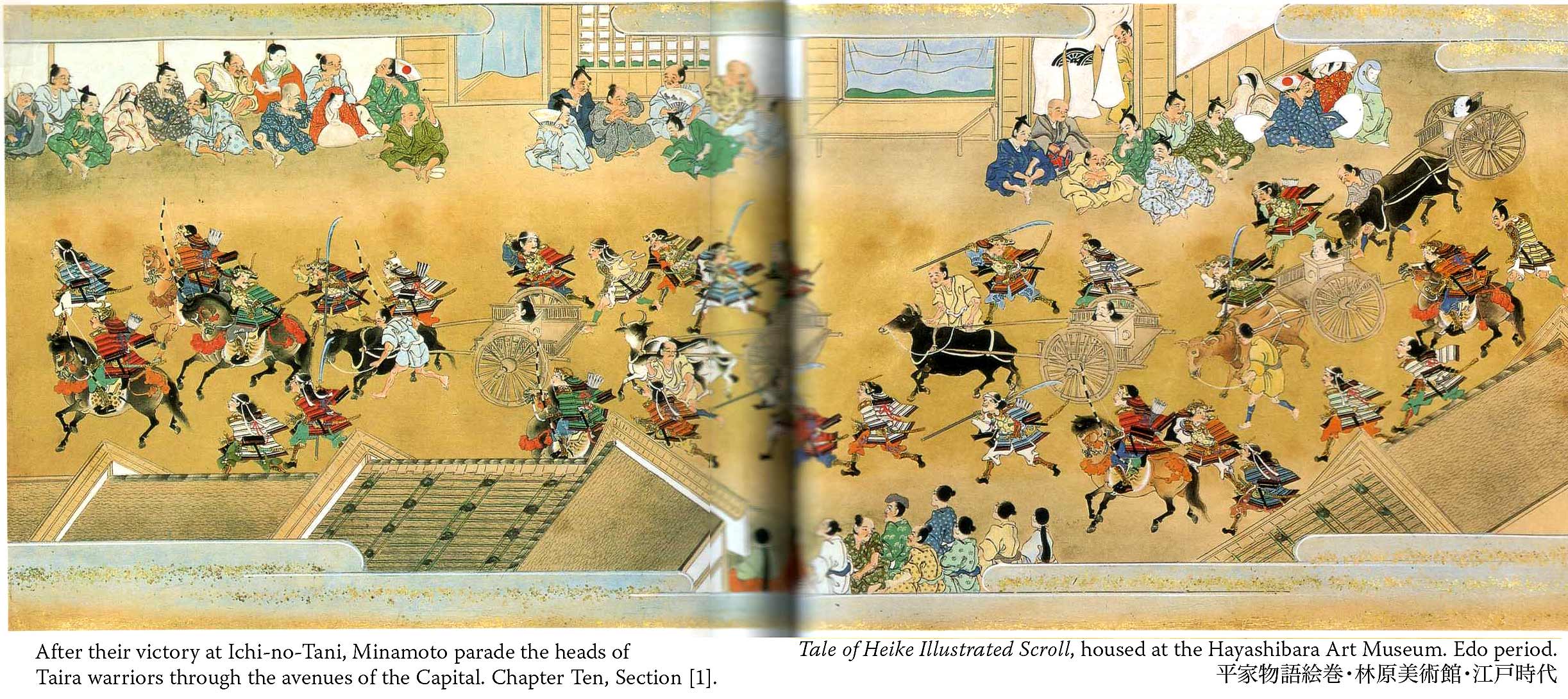
10-[2] The Lady-in-Waiting at the Imperial Palace --- Taira no Shigehira, captured alive, is paraded through the Capital's streets. It is made clear that he will be severely punished for burning the monasteries at Nara. (Chapter Five, Section [14].) Later, from his prison cell, he exchanges letters with a mistress who serves at the imperial palace. The end of this section tells us the ultimate fate of Shigehira: he will be beheaded at the "southern capital" (Nara, where the monks angry with Shigehira's deeds reside).
Character notes
- Taira no Shigehira, the highest ranking Taira (younger brother of the late clan leader Shigemori) currently captured by the Minamoto
- Lady-in-Waiting is not identified in the text. She is just "one with whom I exchanged words"
10-[3] The Retired Emperor's Edict to Yashima --- Go-Shirakawa demands by letter that the Taira return the three sacred treasures (the mirror, sword, and the magatama jewel) that are the symbols of imperial authority. He threatens to kill Shigehira if this edict is not obeyed.
10-[4] The Reply --- Munemori refuses Go-Shirakawa's order, even if this means the death of his captured brother Shigehira. Their widowed mother is distraught.
Character notes
- Nun of the Second Rank, Principal wife of Kiyomori and mother of Shigehira and Munemori.
10-[5] A Statement of Precepts --- Hônen, founder of the Pure Land Sect, gives Shigehira the Buddhist precepts.
Character notes
- Hônenbô. It is hard to know when written like this in English, but this is Practitioner Hônen, the historically important Hônen (1133-1212) who founded the Jôdô Sect --- "Pure Land" Sect. (There is a second tradition, founded by Shinran, 1173-1263, called in Japanese Jôdô Shin Sect but in English also often called just Pure Land). The contents of Hônen's advice are an outline of Hônen's understanding of Buddhism.
Reading notes
- <335> "But belief (shinjin, literally "a believing heart/mind") is the key to rebirth. You must believe with all your heart (tada fukaku shinjite, literally "just believe deeply");" --- The Japanese words used here are indeed close to the English "belief" and "believe".
- <335> "It is quite common for a layman to receive them" --- This is part of Hônen's revolution: extending the practice of Buddhism beyond the walls of the monastery.
Multimedia
A good web site in English about Hônen and his type of Buddhism is maintained by the Jôdô Shû Research Institute and is at: http://www.jsri.jp/English/Honen/life.html and another, somewhat more sectarian web site is: http://www.jodo.org/about_hs/ho_life.html
Portrait of Hônen at Chion-in, Kyoto
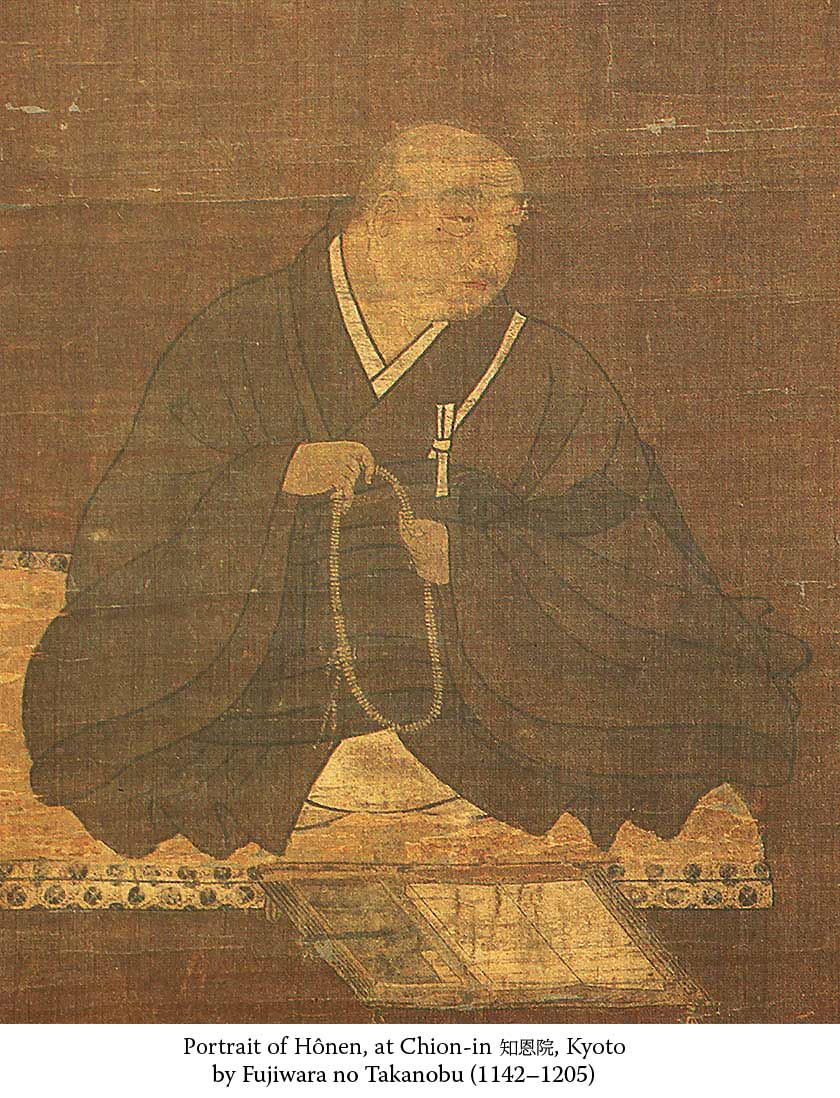
10-[6] The Journey Down the Eastern Sea Road --- At Yoritomo's insistence, Shigehira is relocated to Kamakura, Yoritomo's area of governance and the place where the military capital of Japan will be established at the end of the Gempei War. Shigehira believes he might be executed there. One the way, he spends the night with a woman, the "best poet on the Eastern Sea Road" and a lady (Jijû) who once served his brother Munemori. This section includes several poems that deepen the sense of pathos about Shigehira's fate.
Character notes
- "Jijû" --- This is a title, not a personal name, and means "Personal Imperial Aide" or other roles similar to this. (This woman serves Munemori, certainly not an imperial family member, but probably at the decree of the emperor.) The point here is that this is a fairly high-ranking title, when compared to the "daughter of the brothel-keeper Yuya" that immediately precedes it, and might give a different impression.
Reading notes
- <335> "Journey Down" --- "down" does not mean "south" (he travels east-northeast); it means "away from the capital."
10-[7] Senju-no-Mae --- Yoritomo receives Shigehira. Shigehira denies responsibility for burning the Nara monastery (Tôdaiji). He is given over to Munemochi's custody, and is treated kindly, including being attended to by a beautiful woman called Senji-no-Mae. Also a daughter of a brothel-keeper, she has served Yoritomo. Thus the women of these two sections make something of a pair. In these sections Shigehira is, in Yoritomo's own words, shown to be "a man of the utmost cultivation." Senji-no-Mae becomes a nun after Shigehira is executed.
Reading notes
- <339> "lady-in-waiting" --- This term, nyôbô, puts this 20-year-old girl at about the same rank as the woman in the previous section. (Jijû is a more specific term; nyôbô is generic for women in service at a reasonably high level. . . however, by this period titles were stretched beyond their original hierarchies.)
10-[8] Yokobue --- The scene shifts from Kamakura and the stories involving Shigehira to Yashima, where Koremori pines for his family, whom he had left behind in the Capital when fleeing the Minamoto. He racks his brain for a way to secretly meet them and slips secretly away from Yashima. However, he fears that he will be captured and disgraced just as his brother Shigehira now suffers. He gives up on the idea of going to the Capital and determines instead to travel to Mt. Kôya, center of the Shingon sect of Buddhism. Thus we begin a series of stepped stories; that is, slowly we work towards Koremori's sad suicide. That he has given up trying to see his family and turned towards a Buddhist institution is the signal that his days are now numbered. But first we are given this short story of the love between a man, Takiguchi Tokiyori, who once served Shigemori and a girl, Yokobue. When the man becomes a monk, the woman dies of grief.
10-[9] The Book of Kôya --- The lover-turned-monk of the previous section, Takiguchi Novice, recognizes Koremori. The beauty of Mt. Kôya, and something of the background of the very famous founder of the Shingon Sect, Kôbô (Kûkai, 774-835) is given.
10-[10] Koremori Becomes a Monk --- Together with his two closest retainers, Koremori takes the Buddhist vows, with the intention of soon killing himself. He does have the "sinful" regret, however, of not being able to see his family one last time.
10-[11] The Pilgrimage to Kumano --- Before killing himself, Koremori goes to the Kumano Shrines to honor the deities there. He goes to the waterfall at Nachi, the same place where Mongaku completed his austerities of twenty-one days under the cold water of the waterfall, in Chapter Five, Section [7].
Multimedia
Here, again is a photo of the waterfall at Nachi, courtesy of Steve Zilles
10-[12] The Suicide of Koremori --- Koremori and his two retainers commit suicide by drowning, with Novice Takiguchi in attendance, reading words of Buddhist encouragement.
Multimedia
Koremori commits suicide by drowning
